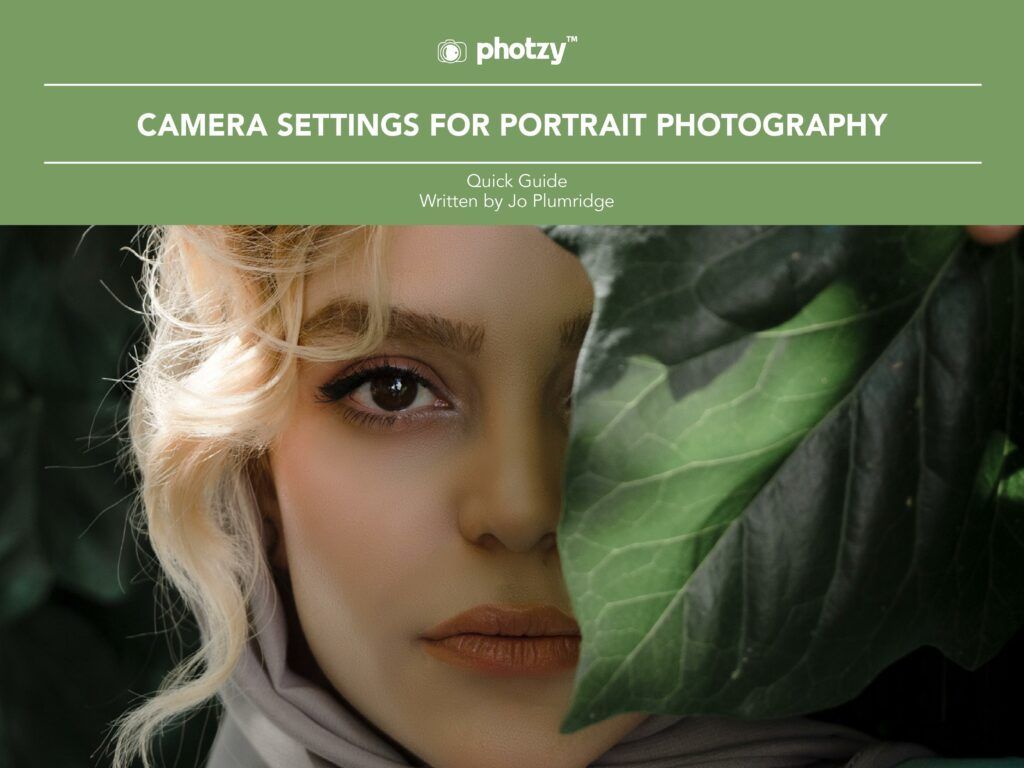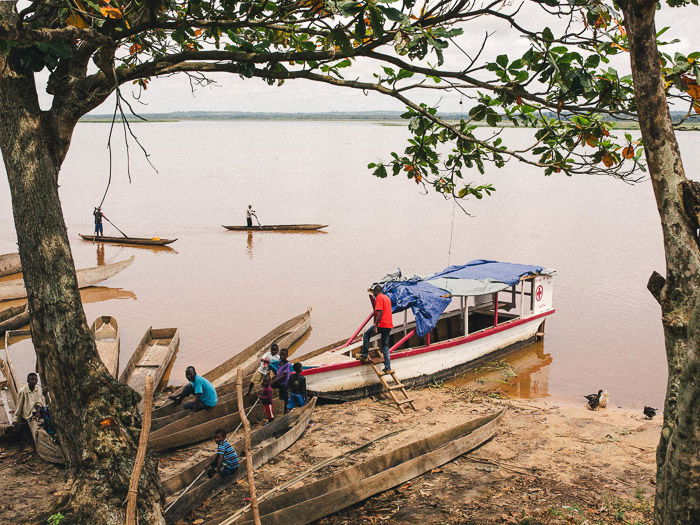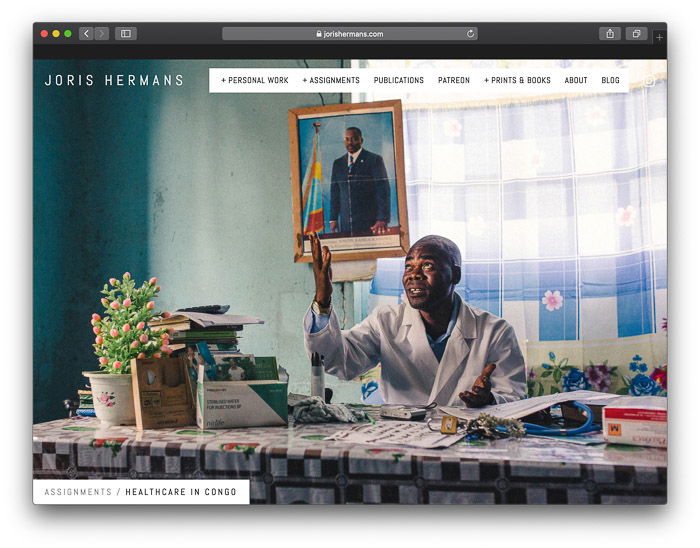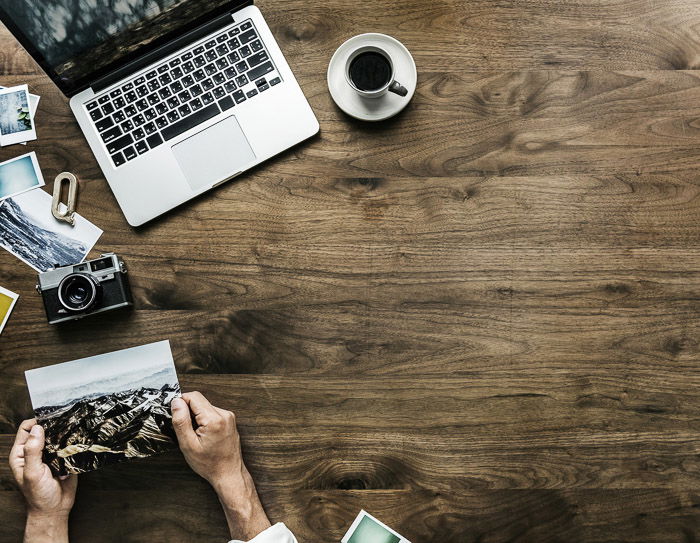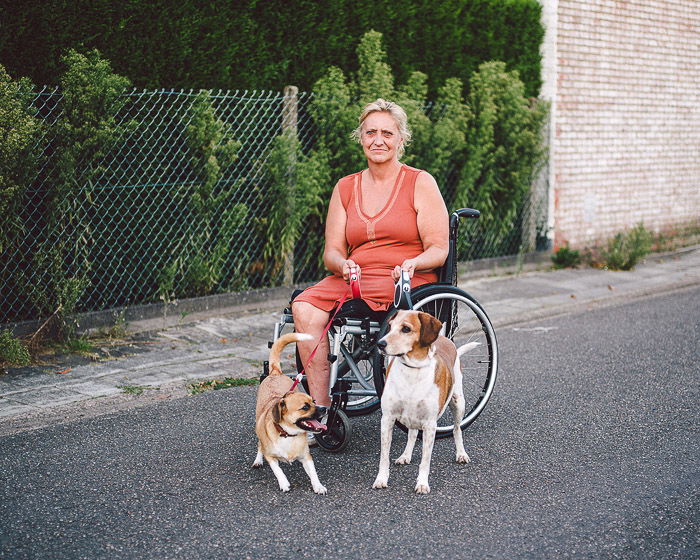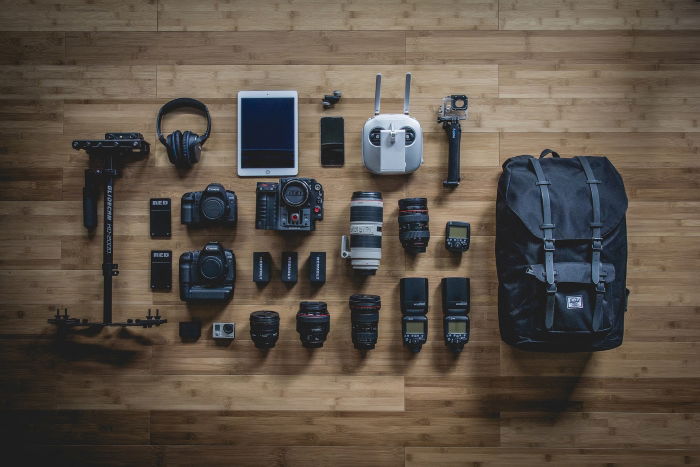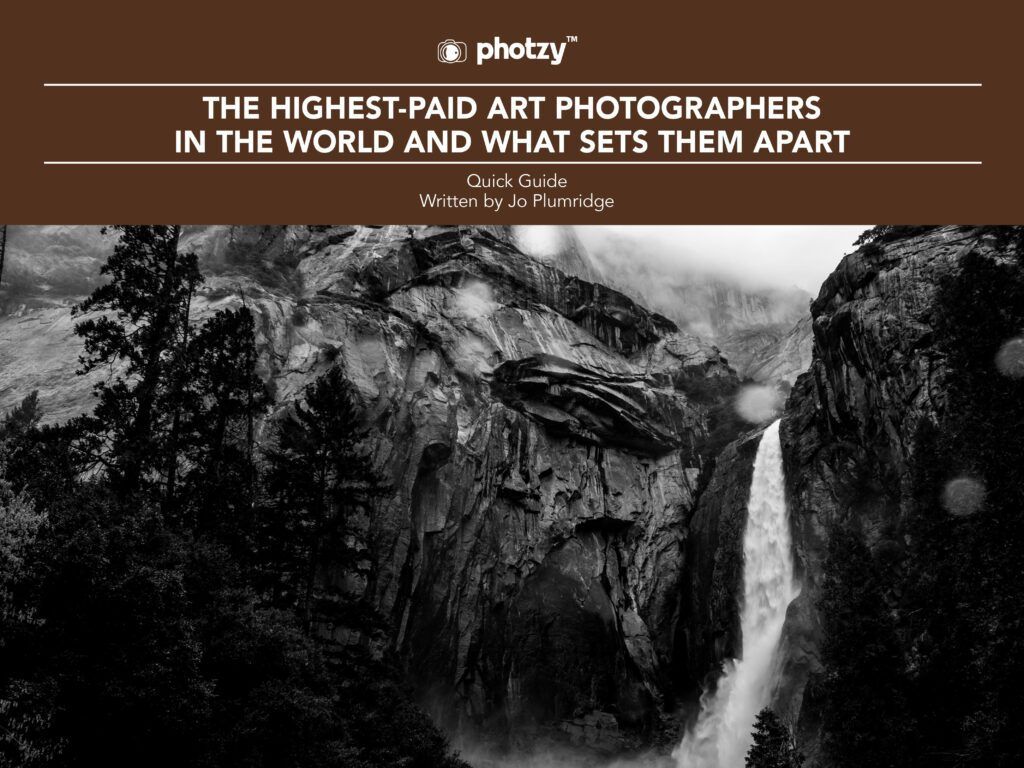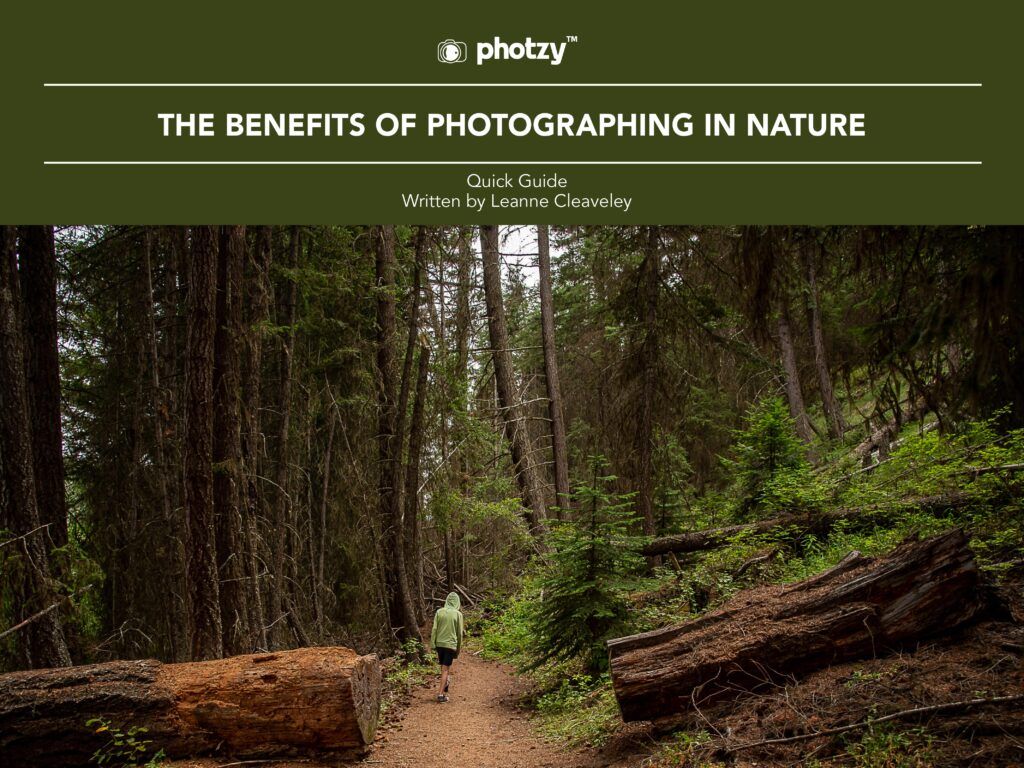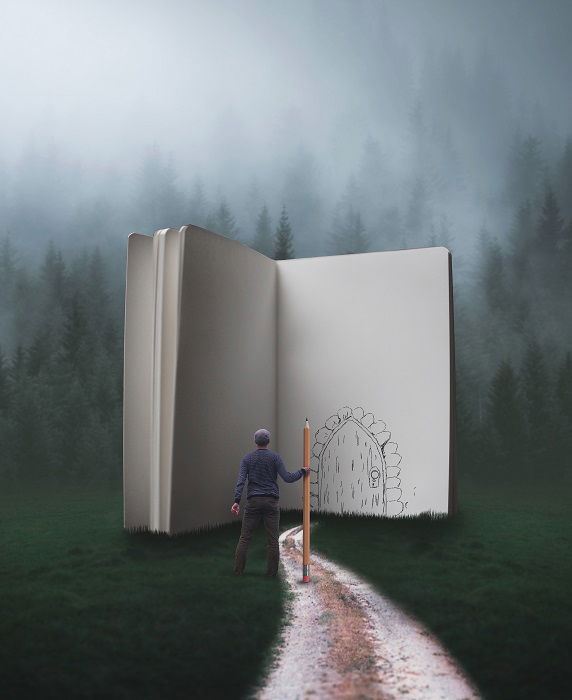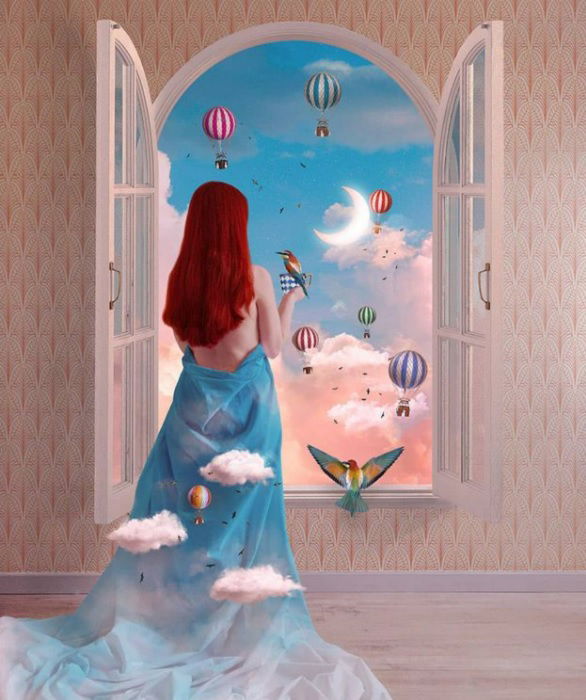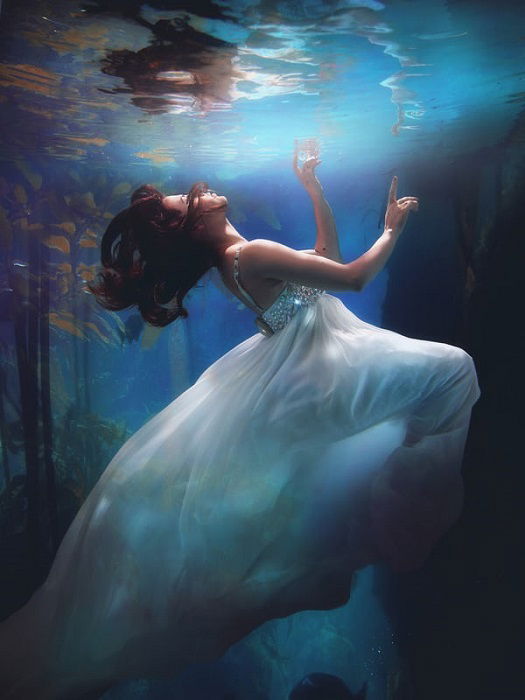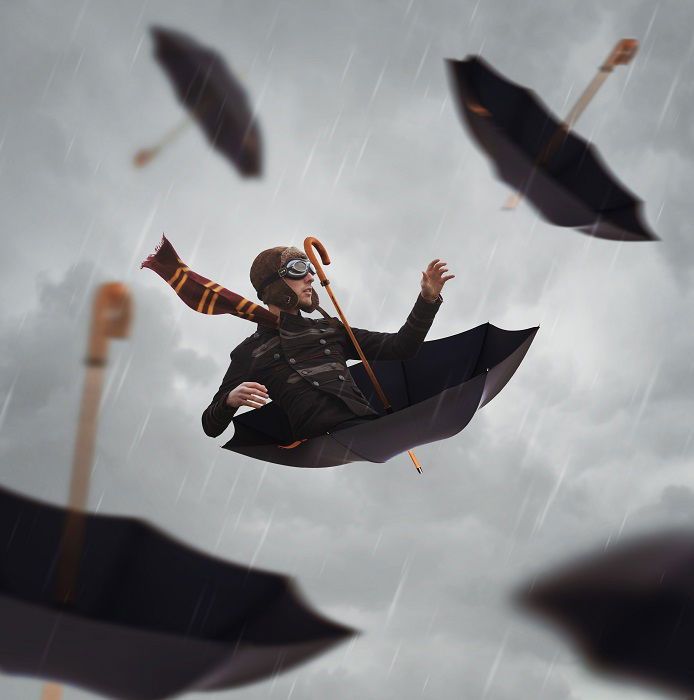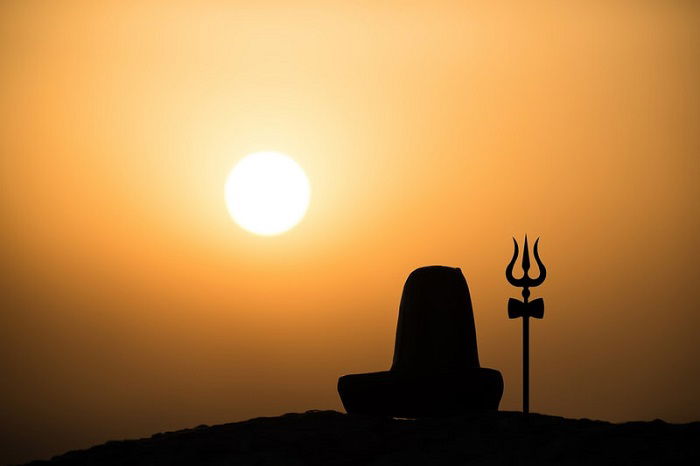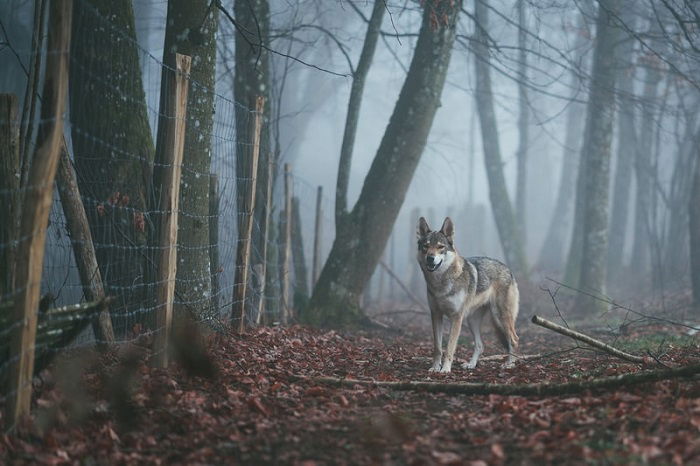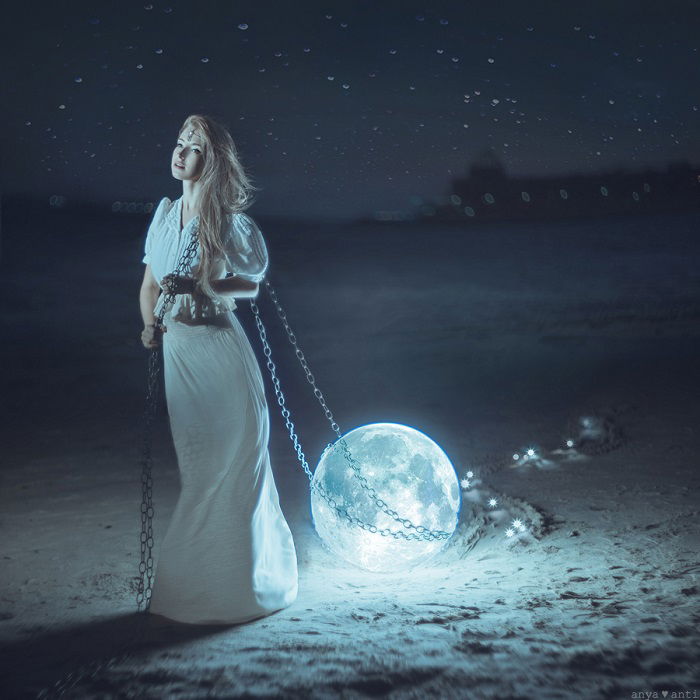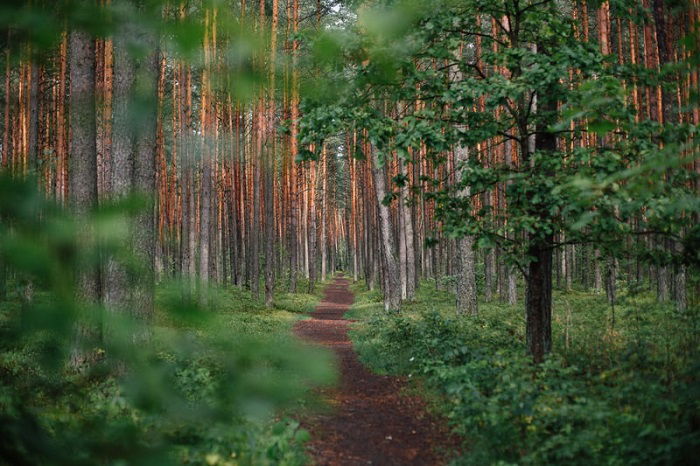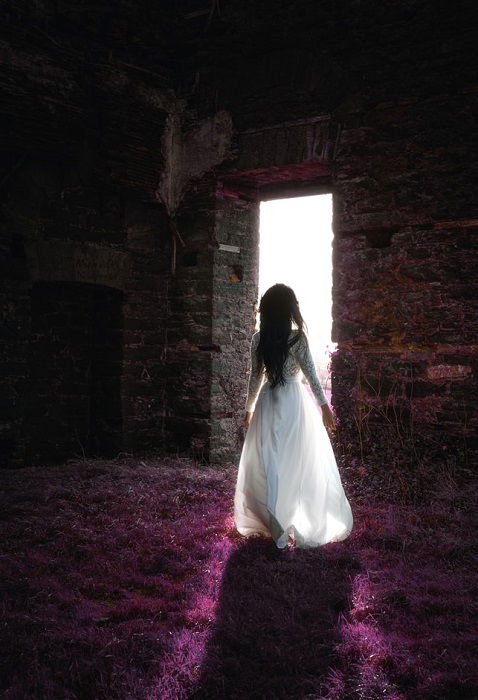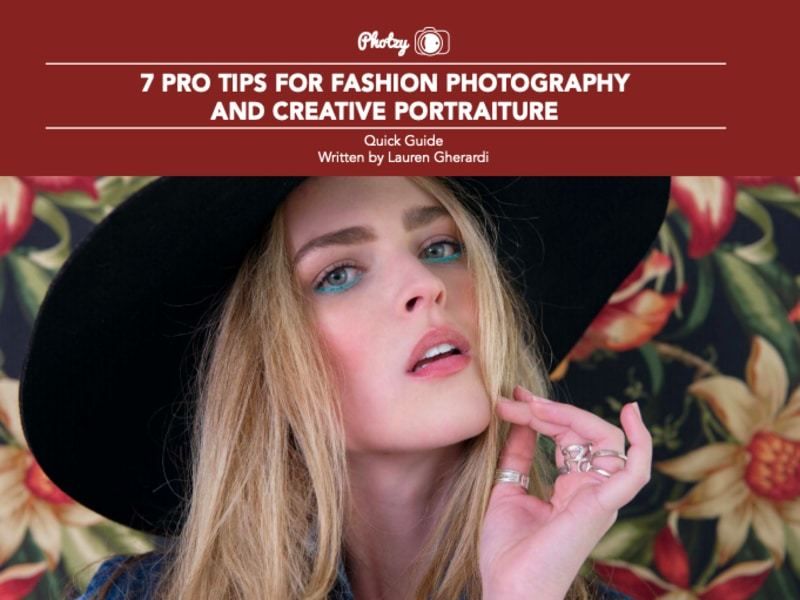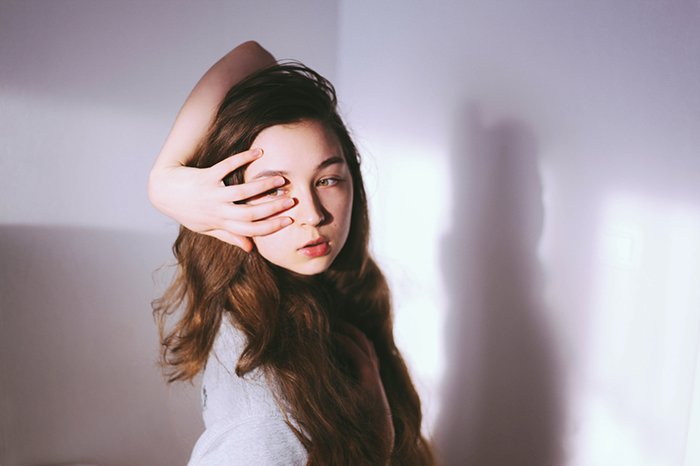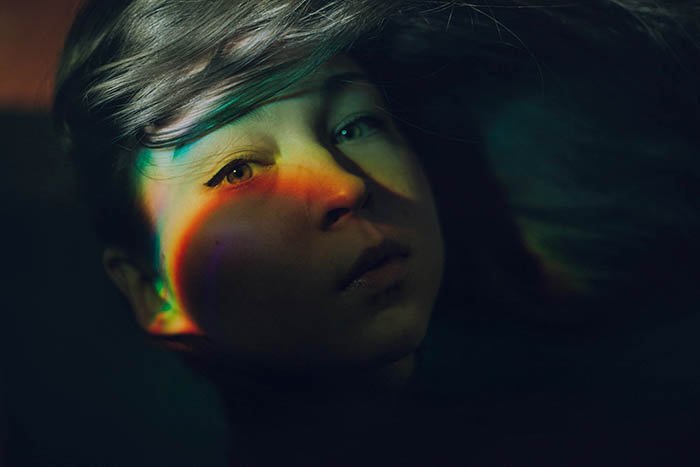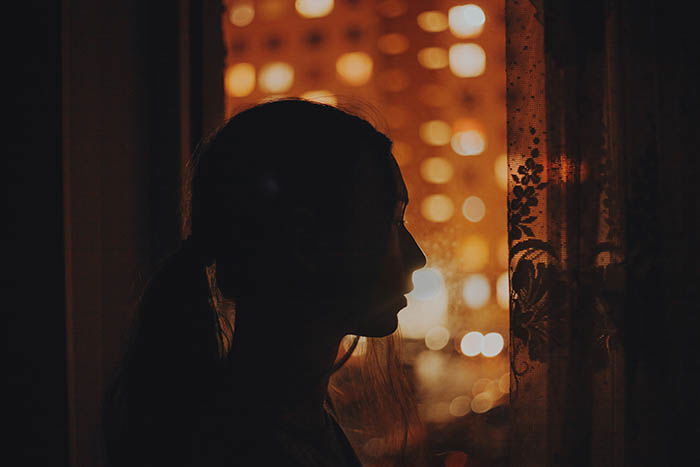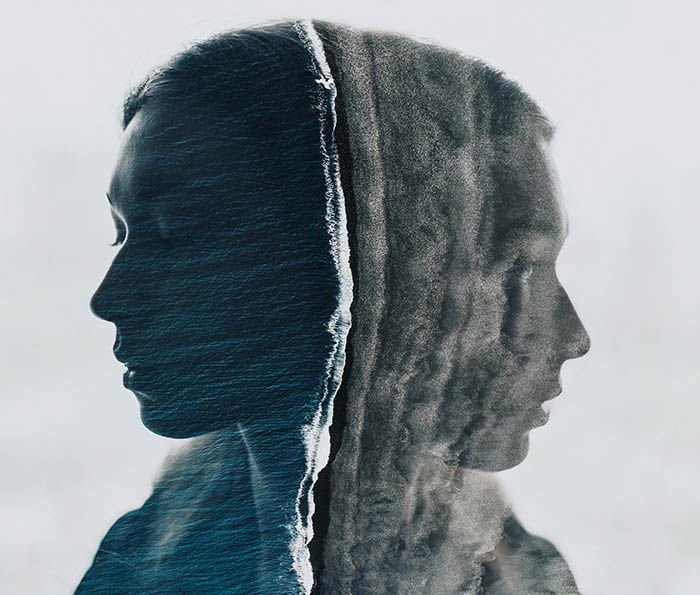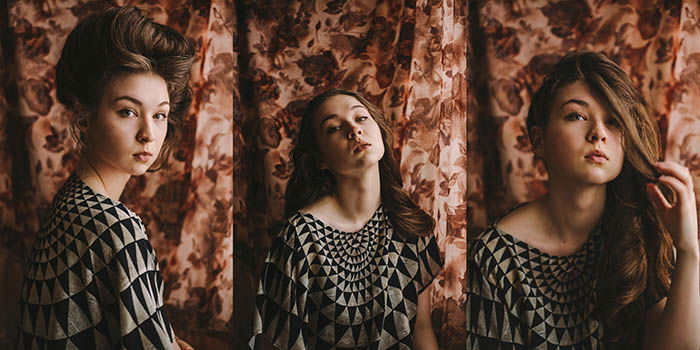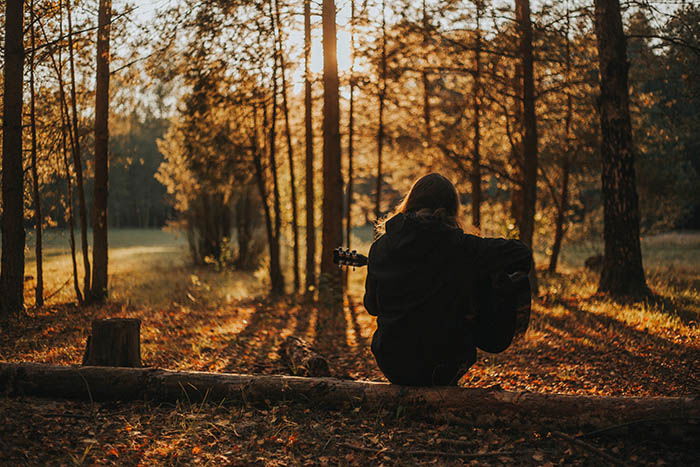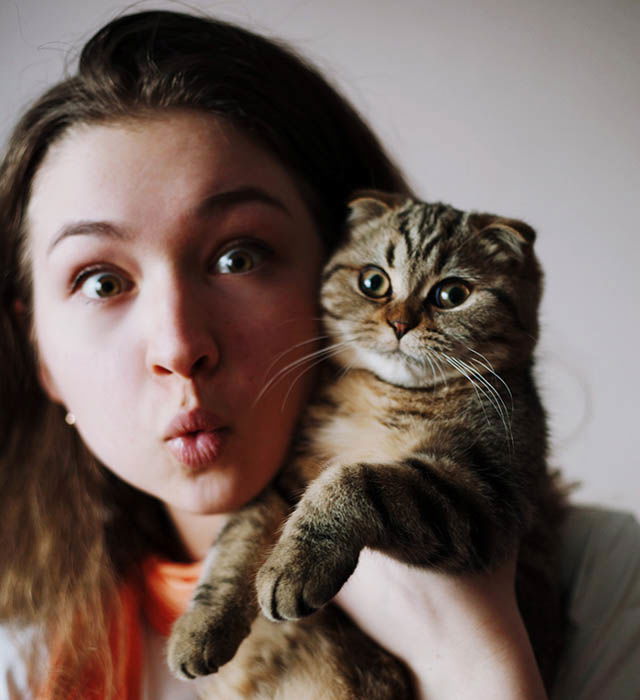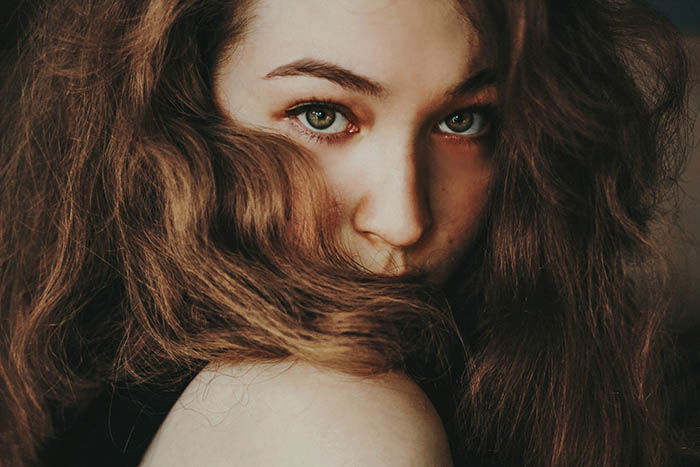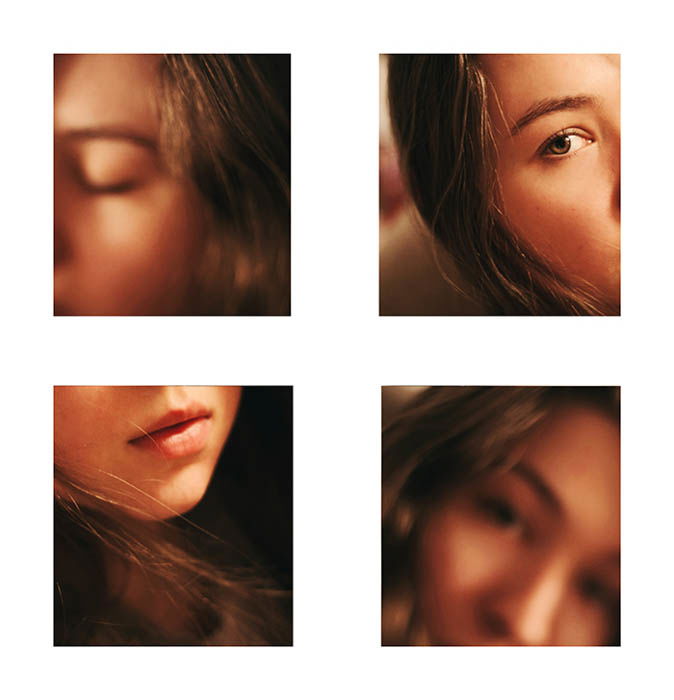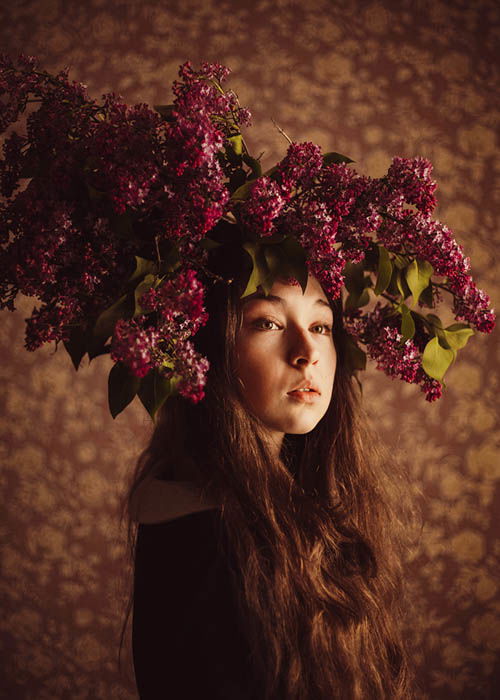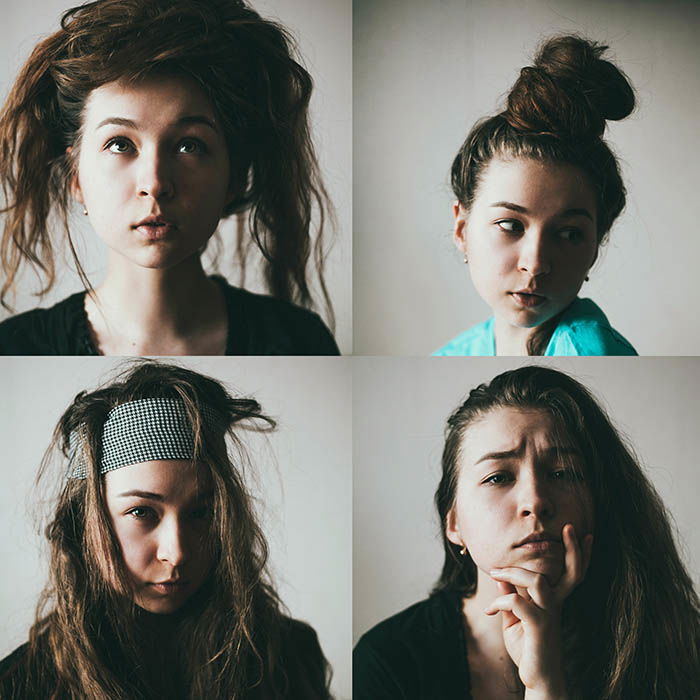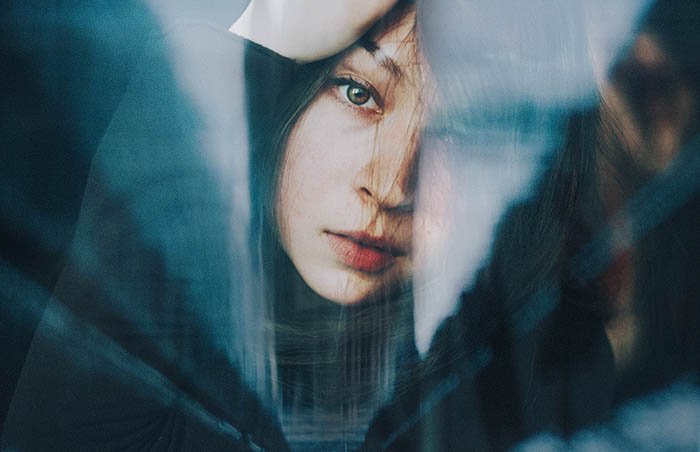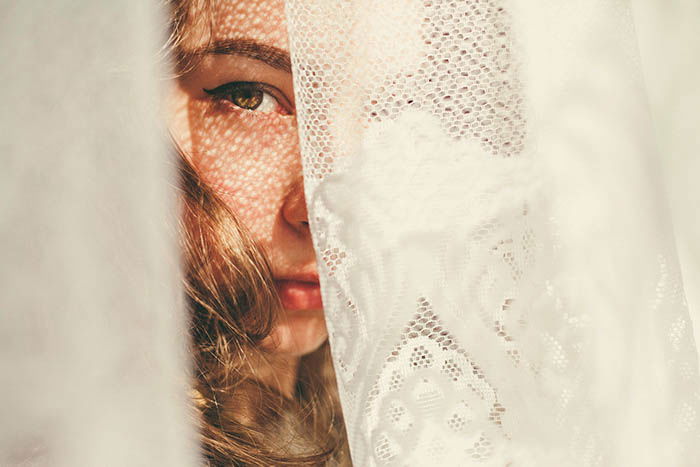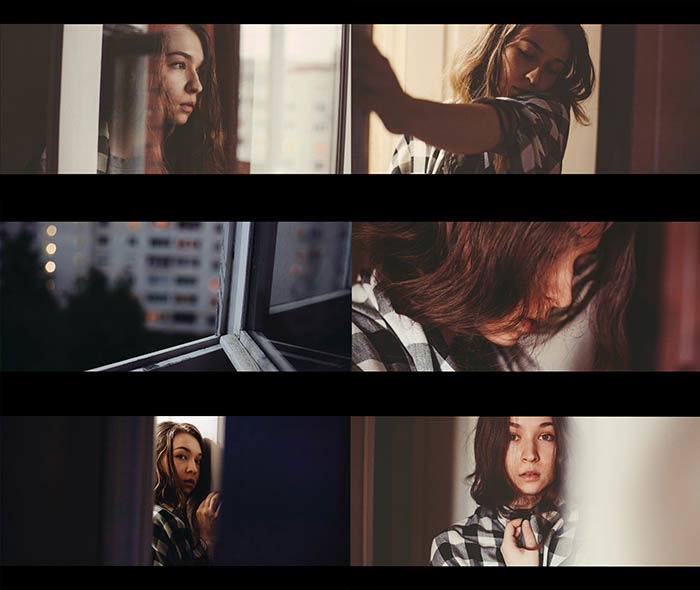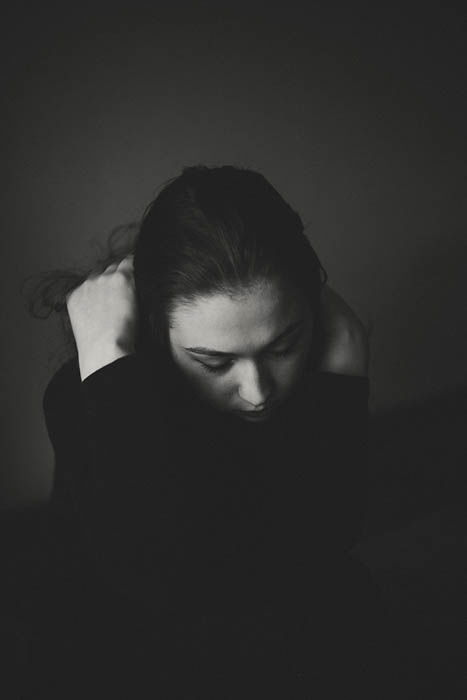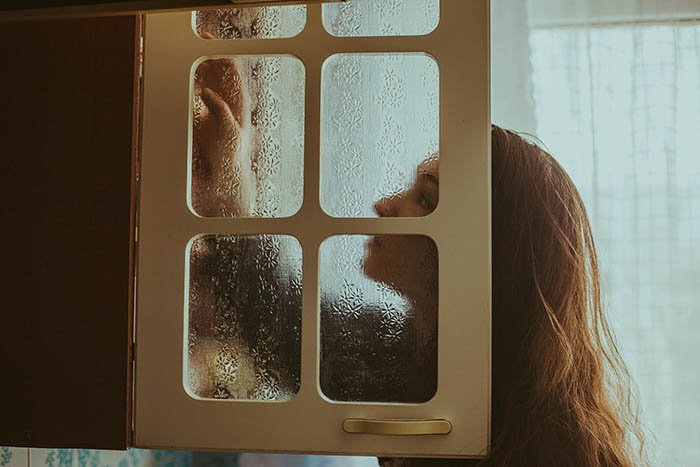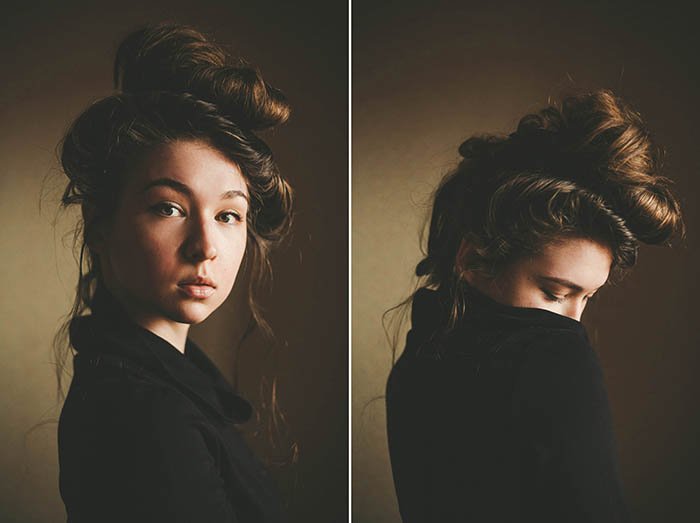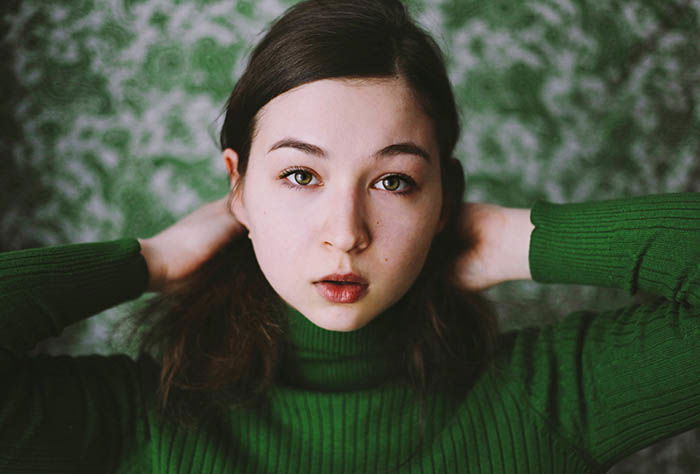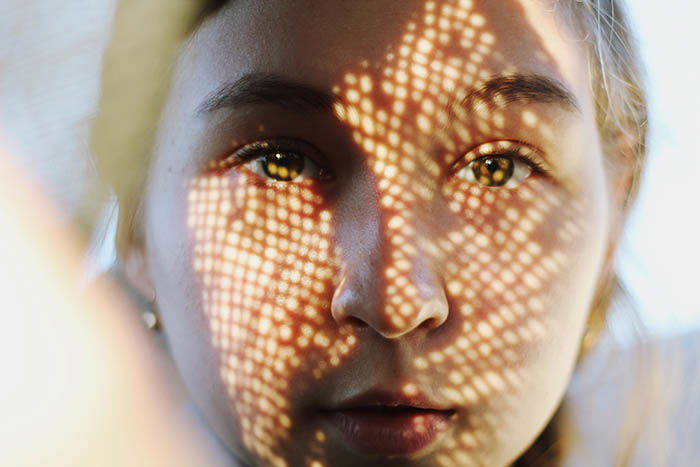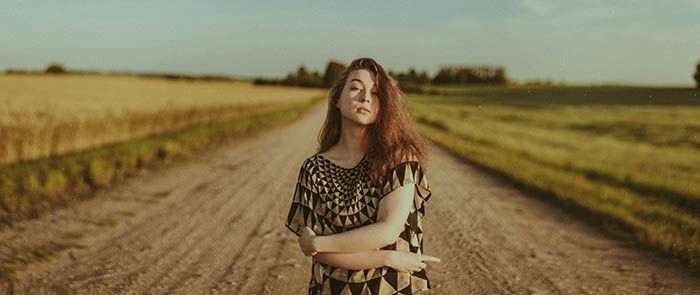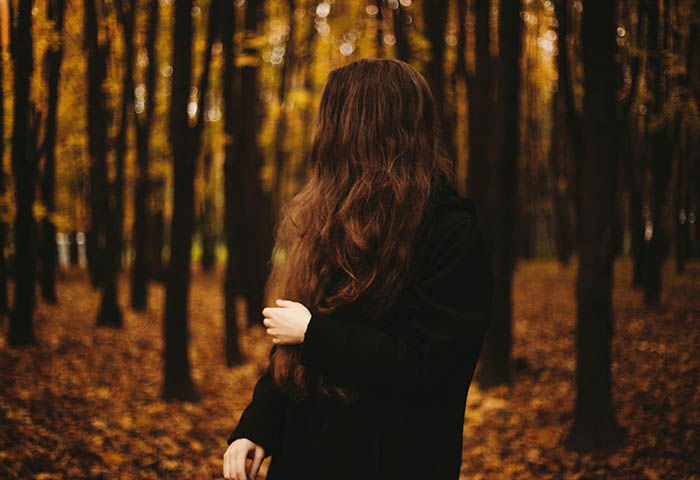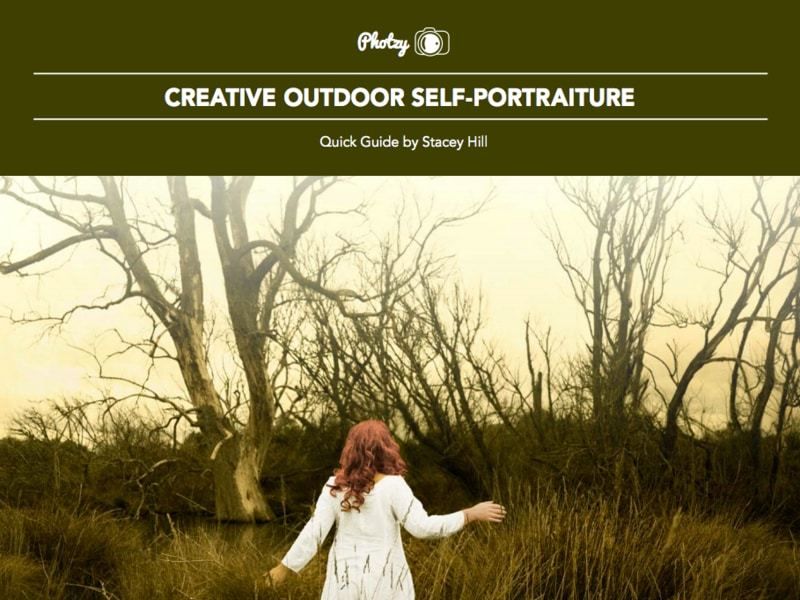16 Best Selfie Poses That Will Transform Your Social Media Account
Today, I’ll be guiding you through my top selfie poses to have you take the perfect selfie! You will have some fun selfie tips to keep your social media fresh and exciting by the end of this article.
I’m sure we’re all familiar with the modern art of the selfie. It can be tough to get such a straightforward photograph just right—especially when you want to show off your best side!
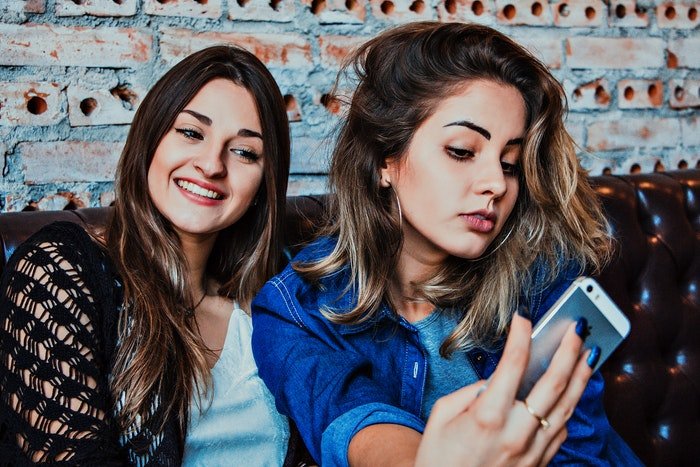
Use Your Current Mood and Atmosphere
The biggest tip I can give you for a good selfie is to let your mood and atmosphere on that particular day dictate the shot. We have all seen pictures where the selfie pose looks too forced or unnatural. You can even tell when a person is forcing a smile.
The best selfie poses are the ones that reflect how you’re feeling, your attitude, or your personality. Perhaps you feel tired and cozy, or you’re outgoing and loud. Pick a selfie pose that reflects your current emotions and who you are.
Of course, the more thought you put into a selfie, the better it will be. But, that isn’t to say it’s a must. Sometimes a spontaneous source of inspiration or lighting will call for a quick snap, which is sometimes the best.
It comes down to familiarity with what works and what doesn’t. The best way to find out for yourself is to try out several different poses in different scenarios. The second best way is to read all these posing tips to help get you on the right track!
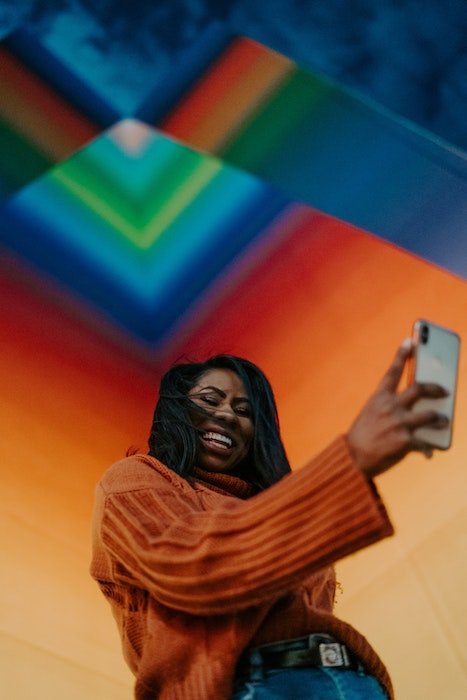
The Best Selfie Poses and Posing Tips
I will now guide you through some easy selfie posing tips to help you find your best creative selfie poses.
16. Show Your Best Silly Selfie Poses
In the beginning, it might feel awkward or forced to pose for your selfie. Let that pressure go!
Try silly poses and expressions that make you laugh. This selfie pose gives your photo playful and easy vibes.
The problem with selfies is that they often seem unnatural. You can avoid this by being yourself and capturing whatever you feel like doing. Remember, no one needs to see these pictures of you. So have fun and try out as many poses as you can.
One tip is to put the camera into burst mode and start playing around. You can also set your phone to video and record yourself trying different, creative selfie poses. Afterward, take a screenshot of the frame you like the best.
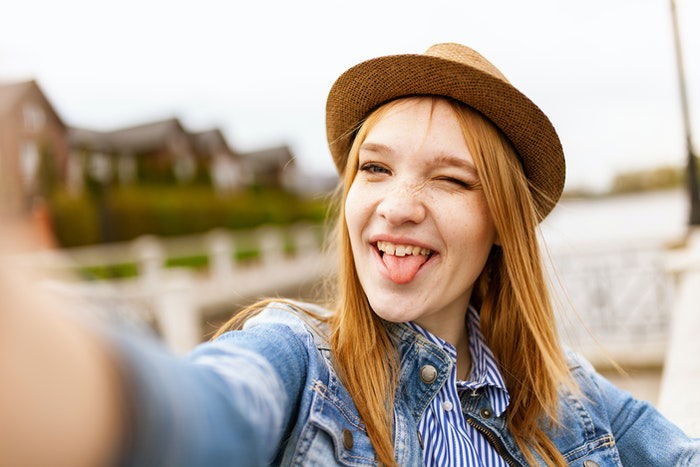
15. Relax Your Lips
Ever wondered why professional models’ lips look so soft and kissable? It’s because they’ve learned to relax their mouth (the opposite of the duck face).
For sexy selfie poses, open your mouth a tiny bit and pretend you are breathing through them. Your lips won’t be pressed together anymore and will look fuller.
Avoid the unnatural duck face with the pouty lips and pressed in cheeks. Pretend you are about to give a gentle kiss to someone. That way, you make your lips look even more enticing.
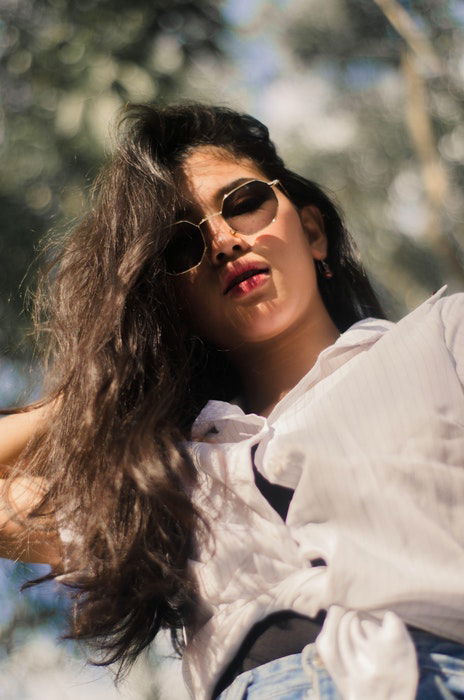
14. Practice Easy-Going Smiles
You might feel awkward when taking selfies alone. But a smile makes every photo look better—even if you have to fake it at first.
To avoid looking uncomfortable, practice in front of the mirror. Think about something that makes you laugh or someone you would love to smile at.
A good technique in selfie posing is first to look down and relax your facial muscles until you are ready to take the shot. Then look up and give your camera a big smile. It will be a more natural smile because you only start smiling a second before striking the selfie pose.
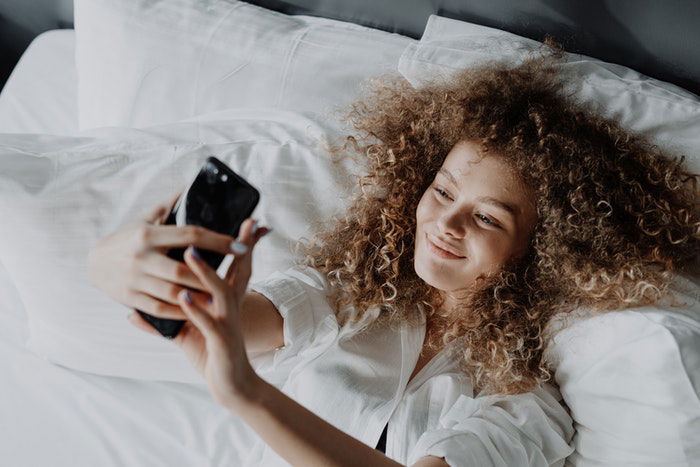
13. Make Your Eyes Stand Out
Eyes are always the focus of selfies, so you have to make sure they stand out. Find poses that emphasize them as the focal point in your selfie.
You can look straight into the camera. This pose makes you look honest and direct. But keep in mind that many people look like they have cross-eyes if they look at something close to their face. You can reduce this effect by looking a bit underneath the camera lens.
If you use a selfie stick, try raising it in the air. It forces your eyes to open a bit more. (This selfie pose also guarantees you won’t have a double chin!)
And if you have bright-colored eyes, they pop even more if you take the selfie from above your head, especially if you use good lighting.
You can also “squinch” in your selfies. It’s a popular facial expression for models. It looks a little bit like squinting, but your eyes shouldn’t narrow too much. The pose gives your face a cheeky and playful look.
Or you can also look away from the camera and pretend you don’t see it. This is an excellent candid pose if you are camera shy.

12. Show-Off Your Style With Full-Body Selfies Poses
People often take selfies that only include their faces. But a popular pose is to include your whole body.
This can be tricky, but it is one of the best selfie poses when executed well. That’s because the full-body selfie allows you to show off your outfit and environment to reflect who you are too!
It may be tough to find the best angle and the most flattering selfie poses to highlight your features. Again, test out a couple of posing ideas each time you take one.
An excellent idea for the full-body selfie is to make a mirror selfie. It’s an easy way to fit your whole body in the frame. You can also see yourself and correct a pose if you don’t like what you see with mirror selfie poses.
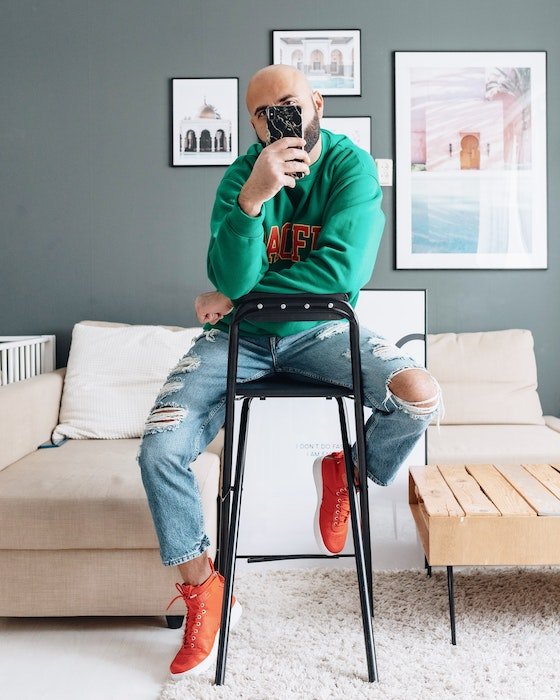
11. Include Your Hands for Natural-Looking Portraits
Poses using your hands can make your selfie look more natural. Gently touch your face or place your chin on your palm.
One popular selfie pose is to play with or lift your hair. It’s another selfie pose that makes your image look candid. You can also use your hair to cover parts of your face if it’s long enough! If you are wearing a hat, you can also place your hand on it.
We touch our faces a lot more than we realize. If you do the same in your selfie, it will convey a more spontaneous shot.

10. Steady Your Selfie Pose With Both Hands
Take a selfie while holding your camera or phone in both of your hands. Your arms will steady the photo’s composition and allow you to frame yourself with more control and intention.
Holding your camera with two hands and raising it high forces you to stick your neck forward. And having your neck forward means more definition in certain areas and will eliminate any unwanted double chin.
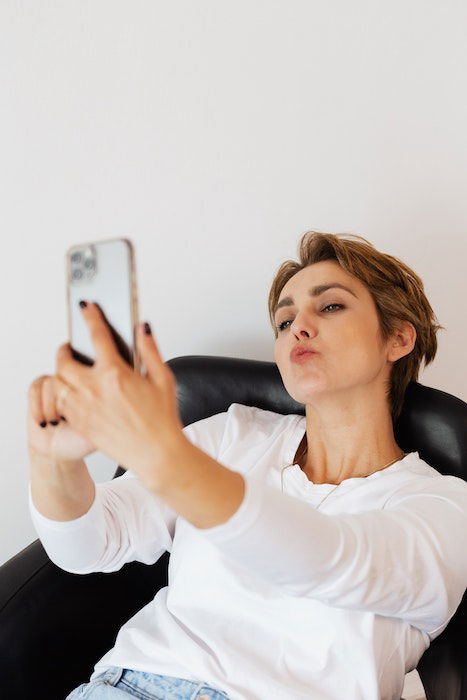
9. Use Unusual Angles
Many people take selfies from or a bit above their eye level. Spice things up and look for different angles. Taking a selfie from the ground gives an exciting perspective to your photo.
Or use a selfie stick and place it way above your head. Selfie sticks can create many new angles you can experiment with. Plus, selfie sticks help you avoid facial distortions.
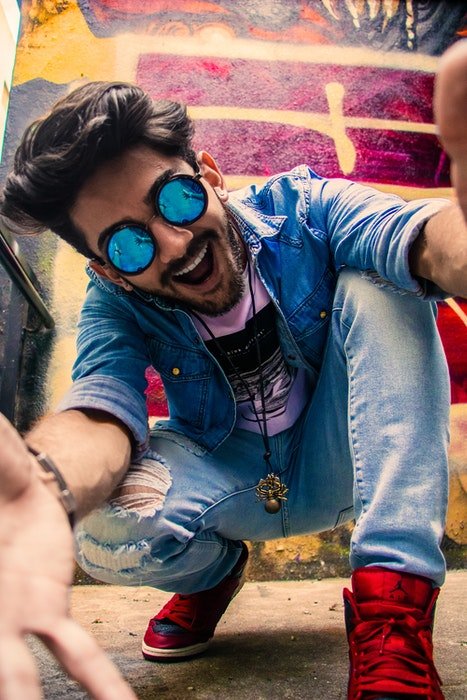
8. Capture Moments Together
You don’t have to be alone in your selfies. Involve your friends and take group selfies!
To fit everyone in, make sure that the person taking the photo is standing a bit further from the rest of you. They’ll be in the foreground and the rest of you in the background.
The selfie photographer can also stand on a higher or a lower spot to ensure everyone fits in the frame.
This is another technique that works beautifully as mirror selfies. Luckily, many bars and art galleries have attractive mirrors, so keep an eye out for mirror selfies with friends!
Pictures with friends tend to be the best selfies as they’re the ones you will cherish the most!
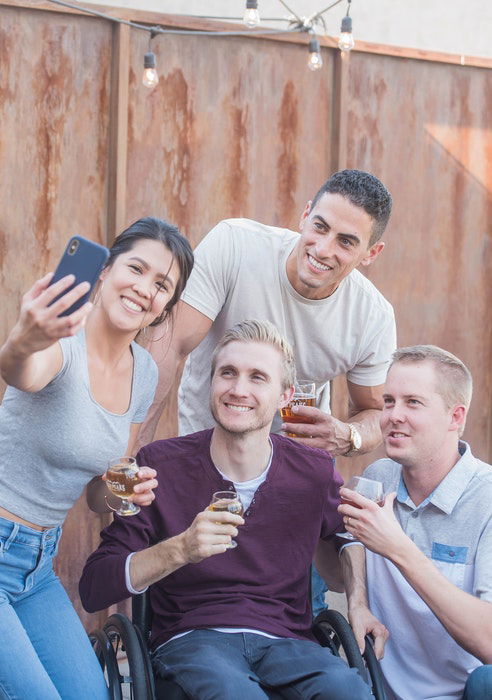
7. Invite a Furry Friend
Selfie poses with pets are always fun. Plus, you never know what the result will be.
Many animals don’t like to stay in one position, so they constantly change how they pose for the photo. This means you will need more patience to get the perfect selfie pose.
Be mindful that your pet is comfortable and that you aren’t forcing them to be in uncomfortable positions.
When you take a selfie with your pet, gently hug them or hold them to ensure their movement is not too sudden. Otherwise, you end up with a blurry selfie.
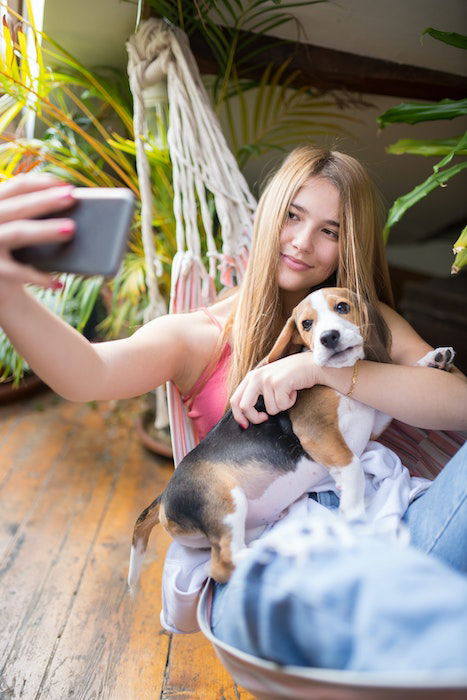
6. Take Selfies While Doing Something You Enjoy
Do you like riding bikes? Capture poses with your bicycle. Do you enjoy dancing? Snap a selfie while you dance around.
Do you love cooking or baking? Try selfie poses while you are preparing a dish in the kitchen. Not only does this give you the chance to show off your food, but also to show off yourself!
The best selfies always come from a place where you are enjoying what you are doing! You will naturally have the best selfie if you capture an activity you love.

5. Go Underwater
Underwater selfie poses are unique and fun. You can take them with an underwater camera, GoPro, or even the newest, waterproof smartphones.
If you can, try to keep your eyes open. You can also try to smile for the underwater selfie.
But don’t stress too much about your facial expression. You can also blow up your cheeks and hold your breath.
This selfie was taken snorkeling in Indonesia. Everyone looks ridiculous in a snorkeling mask. So the photographer thought she would embrace the look and capture her frog face under the water.
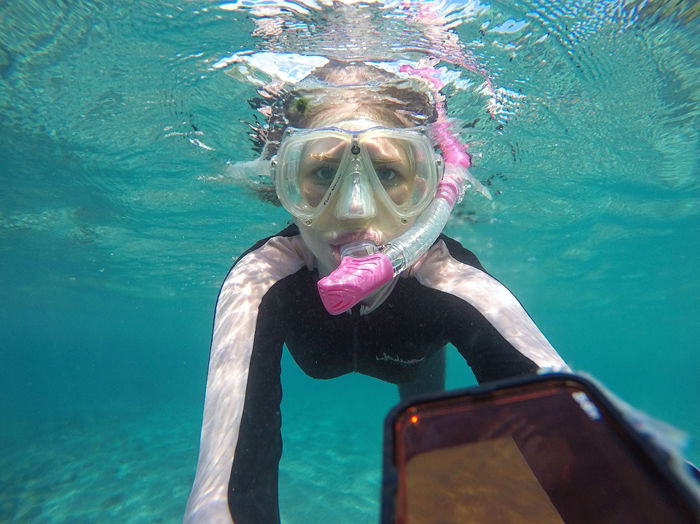
4. Use Unusual Poses or Exciting Activities
Many people take selfies while standing or sitting down. Why not spice things up and capture yourself in more exciting selfie poses?
Stand on your head or do a gymnastic bridge if you can. Or any yoga position can work well.
Take a selfie while bungee jumping or on a rollercoaster if you’re feeling adventurous. Just remember to hold onto your phone!
The main goal is to be creative and find new posing ideas for your selfie game.
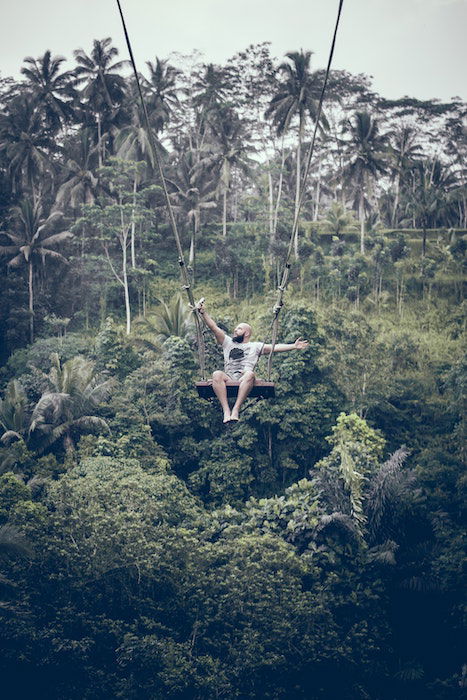
3. Go Meta
This concept belongs to the category of more abstract selfie ideas. But the results can be pretty effective. Find or print a photograph of yourself and take a picture of it.
A fantastic idea is to capture a Polaroid photograph with a fascinating location in the background. Polaroid photographs are perfect for this idea as they have a terrific aesthetic.
It’s not a traditional selfie, but it’s creative and unique. It’s an easy way to get your best selfie.
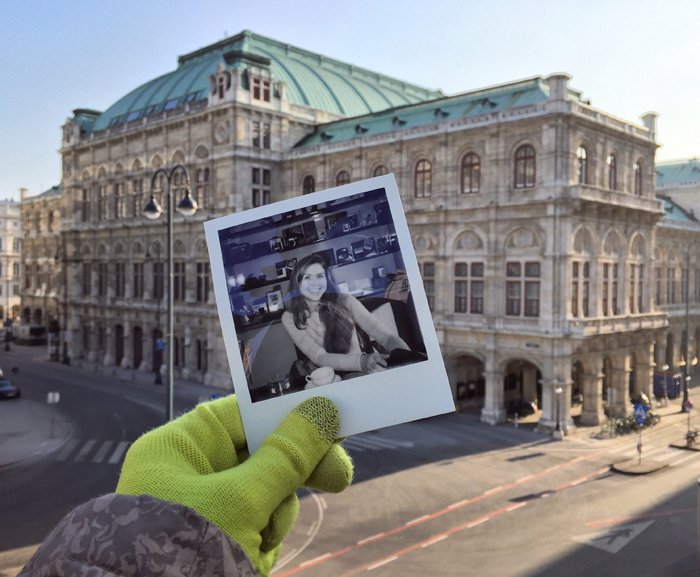
2. Find Unique Locations
Selfies get much better when the background includes an exciting location. Strike a pose if you travel to a well-known city, if you are in nature, or have a famous building in the background.
Make sure you use natural light the best you can. Sometimes, the sun won’t agree with you when trying to fit a specific location into the background. Try different angles to see what you can get away with!
Avoid harsh midday sun. It’s best to wait for golden hour or blue hour.

1. Take a Mirror Selfie in a Different Way
Mirror selfies are an easy way to get your best selfie. There is no surprise the mirror selfie is one of the most popular selfie poses. But, an excellent way to stand out is to think outside the box!
Take a photo of yourself while focusing on a mirror with your camera. You can use a car mirror. Or maybe you would like to photograph yourself in a shop reflection or even a warped mirror!
There are lots of different options for some creative results. Keep an eye out for mirrors wherever you go.

4 Tips to Take the Perfect Selfie
1. Consider Your Lighting
Lighting is the most critical factor to consider when taking a great selfie. If you are not familiar with how your face changes depending on where the light source is coming from, you should watch this YouTube video.
One golden rule is to not shoot with the light source behind you or the camera pointing toward the light.
You will likely work with natural light for most of your self-portraits. This is my favorite type of light to use. Look for a warm glow during golden hour or nice even lighting on an overcast day.
Be careful about the direct sun that can cause harsh lighting. It can often cast unwanted shadows across your face, taking away from your beautiful natural features. You may also get a dark shadow in your eyes,
Even light tends to be the best selfie light. Models and influencers use a ring light around their cameras to get the most even light. You can now get small ring lights to attach to phones or ones that act as a lamp that you can have at home!
2. Be Aware of the Background
Often, we can overlook what is going on in the background while trying to get our best selfie poses. When we see our photos later—sometimes too late—we notice how a simple detail can ruin the whole image.
An easy way to address this is to look for a neutral background. Maybe there’s a wall with a simple color or pattern. Or maybe there’s a tree or bush that looks interesting.
If you’re trying to get a specific location in the background, your subject will likely be so far from the camera that there will be a clear separation. If there isn’t, you can always use the sky to ensure nothing is distracting directly behind your face.
Be mindful of particular objects that can ruin the mood of your selfie. Small things like trash bins or toilets never look great in a selfie. Make sure you adjust your angle slightly to take these objects out of the frame.
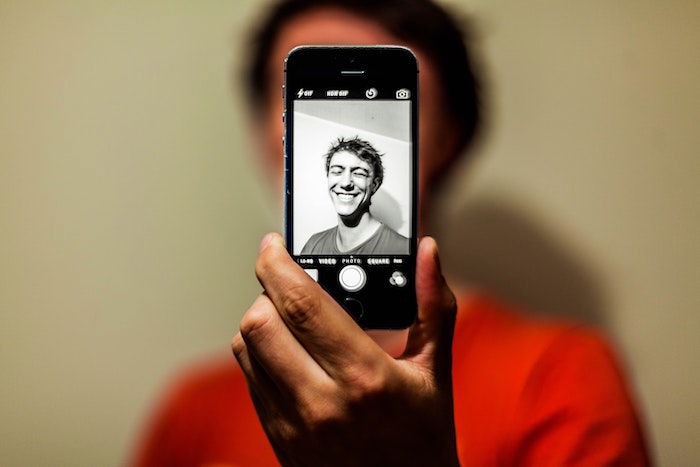
3. Use Portrait Mode
Smartphones nowadays have an excellent AI ability to simulate a shallow depth of field. The camera focuses on the focal point, and everything else is slightly blurred out.
This method makes sure that no attention is taken away from your beautiful face. It also makes the image look sharper as everything else is out of focus.
Sometimes the AI will only work when you are a certain distance from the camera. That means that a full-body shot most likely won’t work in a Portrait mode image. This restriction is worth keeping in mind!
4. Let Out a Great Big Laugh
Sometimes, we want to show our friends and family we’re happy—but not in a fake way. One method of looking happy naturally is to simulate a great big laugh.
Often, this will cause us to laugh for real, especially if we are with friends. There is even a whole yoga practice around fake laughing.
So next time you pose for a selfie, give it a go. You can even try it with a friend!
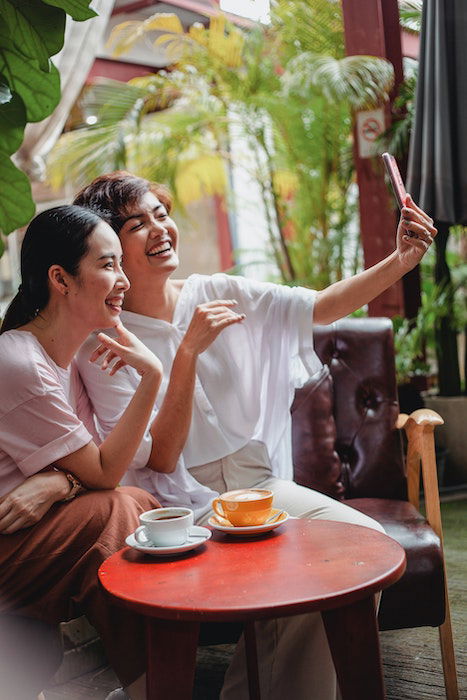
Top Tips For Men and Women
Poses for boys and girls can be a bit different at times. But don’t box yourself into one category or the other. Use what works best for you.
Easy Selfie Poses for Boys
- Square your shoulders for a broad look
- Stand with good posture for a confident pose
- Squint your eyes slightly for an inquisitive look
- Push out your jaw for a stronger line
These are a few examples of how you can make guys look better in selfies. For a more in-depth look, check out our article on poses for men.
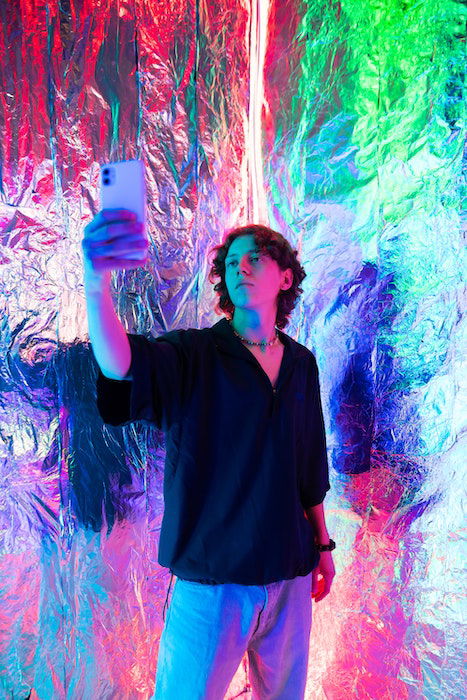
Easy Selfie Poses for Girls
- Play with your hair for a natural look
- Pose in front of a mirror to show off your curves
- Raise your chin for a confident look
- Open your mouth slightly for a sexy look
Again, these are only a few posing tips for female selfies. To see more ideas, check out our guide for female portrait poses.
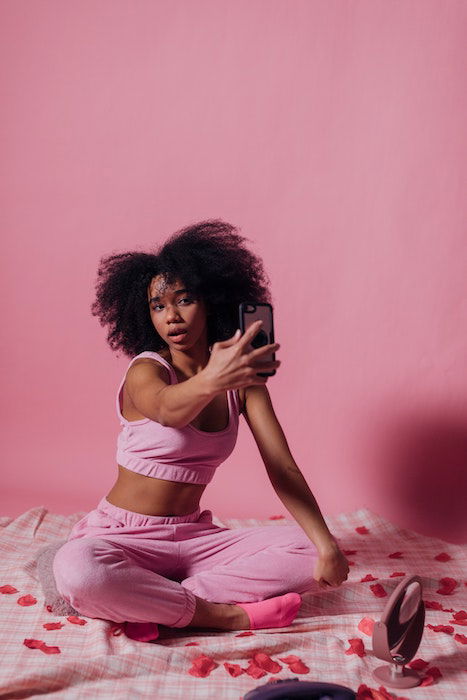
Selfies are great fun and an excellent way to practice your posing and self-portrait skills. To avoid taking mainstream selfies, try out new selfie poses and see what works best for you.
Remember, a good photograph takes practice! So, find the poses and the situations which work best for you! Soon, you’ll have an Instagram feed covered in pictures that show you living your best life!
---------------------------------------------------------------------------------------
